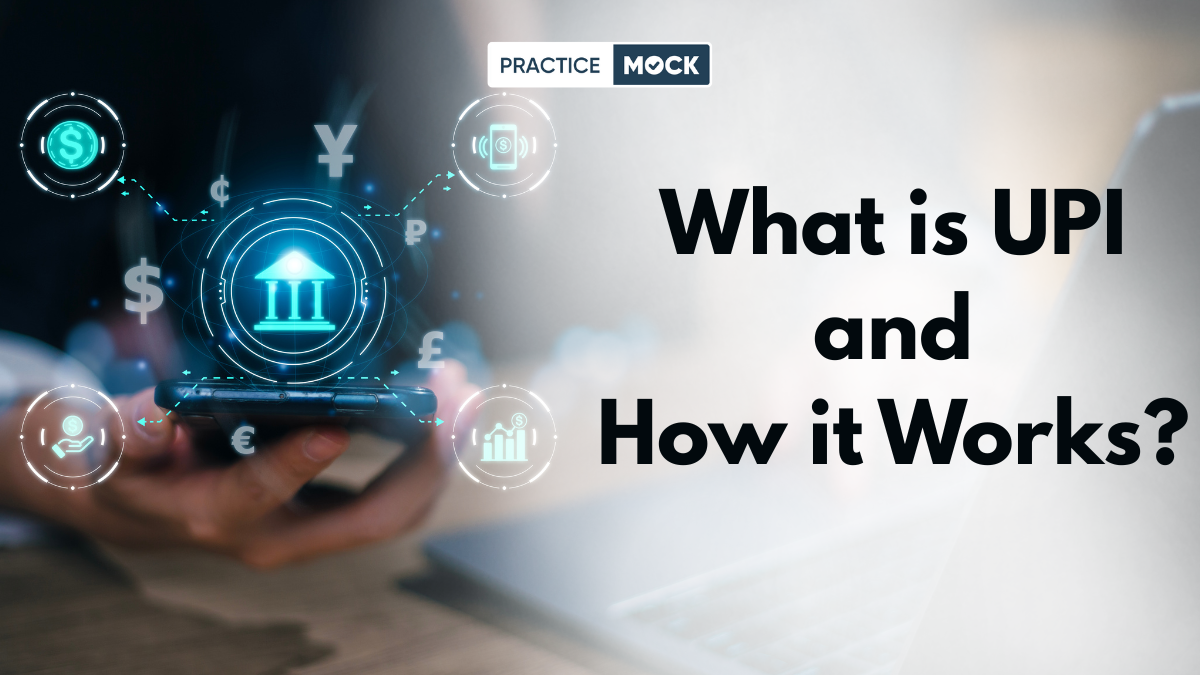The full form of UPI is the Unified Payments Interface. It is frequently asked in the Banking Examinations. It is a real-time payment system that allows users to instantly transfer money to different bank accounts. A single mobile application can be used for making instant payments. For security purposes, the UPI uses a security PIN and a Virtual Payment Address (VPA). The UPI is considered the backbone of the economy as it plays an important role in providing financial freedom to the common people. Let’s discuss the UPI in detail below.
What is UPI?
UPI is a Unified Payment Interface that is used for mobile transactions over a number of bank accounts. It allows real-time transfers and simplified payments using a single mobile app. This mobile app is connected to your bank account. There are many UPI-enabled mobile applications like Google Pay, PhonePe, etc. in India. It was launched in 2016 under the leadership of Dr. Raghuram G. Rajan (RBI Governor). Initially, only 21 banks were associated with the UPI. And now, over 668 banks are linked to the UPI platform. UPI also enables the linking of multiple bank accounts on a single mobile app. The UPI enables two types of Payment modes: between individuals and between merchants or businesses.
How does UPI work?
The UPI follows P2P (Person to Person) and P2M (Person to Merchant) models. For the real-time transactions, 4 parties are involved. They are Payer, Payee, Beneficiary Bank, and Remitter Bank.
- Payer – The person making the payment.
- Payee – The person receiving the payment.
- Beneficiary Bank – The bank of the payment receiving person.
- Remitter Bank – The bank of the person who is making the payment.
Step 1 – Download PSP: Download the UPI-enabled mobile app, which is called the Payment Service Provider (PSP). Register and add account details and generate the UPI PIN.
Step 2 – Mobile Verification: Verify your mobile number and also verify your account information.
Step 3 – Customer Registration: Now, the customer registration request from the NPCI (National Payment Corporation of India) UPI will be sent to the Bank where the customer has made their account. And the same request will be sent to the Payment Service Provider (PSP) – Google Pay, PhonePe, etc., server. PSP now creates a VPA to proceed ahead.
UPI Official App: BHIM UPI – Bharat Interface for Money (BHIM) is a payment app that enables simple, quick, and easy transactions using the Unified Payments Interface (UPI). With the BHIM app, you can make direct bank payments to anyone on UPI using their UPI ID or by scanning their QR code. You can also request money from a UPI ID through the app.

Step 4 – PIN Generation: Then, the user will select the Generate PIN option in their mobile application. The PSP server will forward the OTP (One Time Password) request to the NPCI, and the NPCI will send the same request to the Issuer bank, and finally, the Issuer bank sends the same OTP to the Customer. After your PIN is generated, neither the NPCI nor the PSP Server is authenticated to save the PIN.
Note: A bank account can have multiple VPAs.
Example: HDFC Bank has multiple VPAs. HDFC App – @hdfc , Google Pay – @okhdfc, PhonePe – @ybl.
How UPI Contributes to the Economy?
The contribution of UPI is significant in the Indian Economy. It fosters the digital economy and enhances financial inclusion. It is contributing to economic growth by increasing efficiency and encouraging cashless transactions. It has made the transactions more convenient for individuals and businesses.
- Boosting digital economy by providing secure platform.
- Increased financial inclusion due to its reach in rural areas.
- It has encouraged cashless transactions and has become easier to use.
- It has contributed to the growth of e-commerce and small businesses by facilitating seamless transactions.
- The UPI’s advancement has paved the way for future innovations and offline payments.
Common Queries Related to UPI
Here we have answered some common queries about the UPI. The candidates must know these as they are frequently asked in the banking examinations as well as interviews. Some of the most asked questions cover ‘When was UPI launched?’, ‘Where was UPI invented?’, ‘Why was UPI introduced?’, ‘Will UPI work outside India?’, ‘Who built UPI in India?’, ‘Who is behind UPI?’, ‘Why was UPI launched?’.
When was UPI Launched?
The pilot launch was on 11th April 2016 by Dr. Raghuram G Rajan, Governor, RBI, at Mumbai. Banks have started to upload their UPI-enabled Apps on the Google Play store from 25th August, 2016 onwards.
Where was UPI Invented?
UPI, or Unified Payments Interface, was invented in India. It was launched by the National Payments Corporation of India (NPCI) in 2016. UPI is a system that allows users to link multiple bank accounts into a single mobile application, facilitating instant fund transfers and merchant payments.
Why was UPI introduced?
UPI (Unified Payments Interface) was introduced to modernize India’s payment systems and promote digital transactions, moving towards a cashless economy. It allows for instant, secure, and interoperable fund transfers between bank accounts using mobile applications. The key goals were to simplify payments, enhance convenience, and reduce reliance on cash and physical payment instruments.
Will UPI Work Outside India?
Yes, UPI can be used for international transactions in some countries. You can use UPI with the “UPI International” feature to pay at merchants abroad who accept UPI-enabled QR codes. Several countries like Singapore, UAE, Sri Lanka, Mauritius, Bhutan, Nepal, and France support UPI payments, with ongoing efforts to expand to more nations.
Who Built UPI In India?
The Unified Payments Interface (UPI) in India was built by the National Payments Corporation of India (NPCI). NPCI is an umbrella organization for retail payments in India, established by the Reserve Bank of India (RBI) and the Indian Banks’ Association.
Who Is Behind UPI?
The Unified Payments Interface (UPI) was developed and is operated by the National Payments Corporation of India (NPCI). NPCI is a not-for-profit organization that was set up by the Reserve Bank of India (RBI) and the Indian Banks’ Association. UPI is a real-time payment system that facilitates instant fund transfers between bank accounts using mobile phones.
Why Was UPI Launched?
UPI (Unified Payments Interface) was launched to revolutionize digital payments in India by enabling instant, real-time bank transfers through a single mobile application. This system aims to simplify transactions, reduce reliance on cash, and promote financial inclusion by making payments accessible to a wider population.
Summary
The UPI, that is the Unified Payment Interface, allows real-time transactions and simplified payments. It was launched in 2016 under the leadership of Dr. Raghuram G. Rajan. In 2025, approximately 668 banks had enrolled in the UPI system. UPI allows linking of multiple bank accounts on a single mobile app. It uses the PSP server and VPA, and NPCI server for its operations. It has significantly contributed to the financial inclusion and economic growth of our country.
Banking Exams Free Mock Test
| IBPS RRB PO Free Mock Test | IBPS PO Free Mock Test |
| SBI PO Free Mock Test | IBPS SO Free Mock Test |
| IBPS RRB Clerk Free Mock Test | IBPS Clerk Free Mock Test |
Join our exclusive Telegram group, where our experts are ready to answer all your queries, guide you in banking exam preparation, and give personalised tips to boost your success. Get access to real-time solutions, expert advice, and valuable resources to improve your study journey.

FAQs
Yes, Google Pay is a Unified Payment Interface Application.
Yes, UPI is available in the, USA for certain transactions especially for the Non-resident Indians (NRIs).
Yes. UPI is secure, and it uses various security measures such as UPI PIN.
There are three major disadvantages of UPI, which include:
Limited transaction amounts can hinder larger payments.
Dependent on internet connectivity, which affects accessibility.
Vulnerable to cyber threats despite security measures.
- Sign Up on Practicemock for Updated Current Affairs, Topic Tests and Mini Mocks
- Sign Up Here to Download Free Study Material
Free Mock Tests for the Upcoming Exams
- IBPS PO Free Mock Test
- RBI Grade B Free Mock Test
- IBPS SO Free Mock Test
- NABARD Grade A Free Mock Test
- SSC CGL Free Mock Test
- IBPS Clerk Free Mock Test
- IBPS RRB PO Free Mock Test
- IBPS RRB Clerk Free Mock Test
- RRB NTPC Free Mock Test
- SSC MTS Free Mock Test
- SSC Strenographer Free Mock Test
- GATE Mechanical Free Mock Test
- GATE Civil Free Mock Test
- RRB ALP Free Mock Test
- SSC CPO Free Mock Test
- AFCAT Free Mock Test
- SEBI Grade A Free Mock Test
- IFSCA Grade A Free Mock Test
- RRB JE Free Mock Test
- Free Banking Live Test
- Free SSC Live Test



